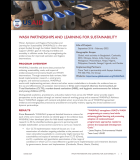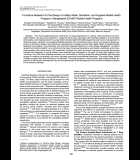Integrated Agriculture-Health Based Initiative (IAHBI)
Approximately one-fourth of Bangladeshis have limited availability, access to and consumption of adequate quantities of nutritious food the year round. Given the fact that food quantity and quality have the most direct links between agriculture, food security and health, investments need to be enhanced in agriculture so that small farmers, particularly women, can make a significant contribution to improve household food security and nutrition. Over the past 15 years, the decline in child undernutrition, particularly stunting,- has not kept pace with the decline in poverty. Though poverty reduction is necessary for combating malnutrition, it is certainly not sufficient. Community-centered food-based nutrition education strategies need to be institutionalized and mainstreamed in agriculture and health service delivery structures to establish sustained nutrition behaviors. Improving nutrition requires focused action through direct nutrition-specific as well as indirect nutrition-sensitive interventions.
Activity Description
The USAID-FAO-UNICEF joint action aims to accelerate and improve nutritional outcomes for women and children in Bangladesh, through integrated agriculture and health based interventions. Together, UNICEF and FAO will ensure improved coverage of direct nutrition interventions, through the health system as well as supplying nutrition-sensitive interventions through the agriculture sector. The duration of this project is from September 2012 to August 2015. The project is implemented in five Upazilas (sub-districts) in Khulna and Barisal divisions (Dacop, Koyra, Assasuni, Shayamnagar and Muradi Upazilas). The target population of the project is 50,000 households with 10,000 pregnant and lactating women and 20,000 children under five years of age.
- Improved household and community nutrition security via homestead and community food production, leading to enhanced intake of adequate and diversified diets among young children and women of child-bearing age.
- Improved nutrition training/awareness learning will lead to increase consumption of adequate, diversified local food.
- Increased access to and uptake of evidence-based direct nutrition interventions through scale up of support to existing systems, structures and enhanced coordination.
Expected Outcomes
- 50,000 households (i.e., approx. 250,000 individuals) reached with project -support food security and nutrition interventions.
- 10,000 PLW reached with nutrition services
- 20,000 children under five reach with nutrition services.
- At least 30 percent of pregnant women in target area comply with iron -folate supplementation.
- At least 80 percent of children 6 to 23 months in target haven taken de -worming tablets in the past year





